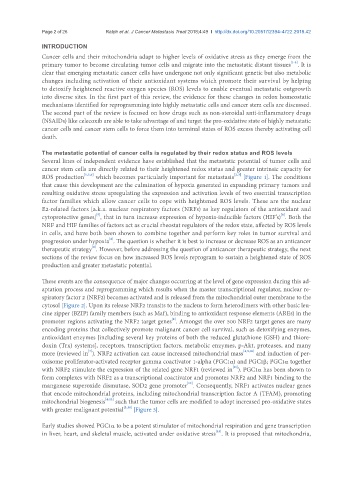Page 582 - Read Online
P. 582
Page 2 of 26 Ralph et al. J Cancer Metastasis Treat 2018;4:49 I http://dx.doi.org/10.20517/2394-4722.2018.42
INTRODUCTION
Cancer cells and their mitochondria adapt to higher levels of oxidative stress as they emerge from the
[1-5]
primary tumor to become circulating tumor cells and migrate into the metastatic distant tissues . It is
clear that emerging metastatic cancer cells have undergone not only significant genetic but also metabolic
changes including activation of their antioxidant systems which promote their survival by helping
to detoxify heightened reactive oxygen species (ROS) levels to enable eventual metastatic outgrowth
into diverse sites. In the first part of this review, the evidence for these changes in redox homeostatic
mechanisms identified for reprogramming into highly metastatic cells and cancer stem cells are discussed.
The second part of the review is focused on how drugs such as non-steroidal anti-inflammatory drugs
(NSAIDs) like celecoxib are able to take advantage of and target the pro-oxidative state of highly metastatic
cancer cells and cancer stem cells to force them into terminal states of ROS excess thereby activating cell
death.
The metastatic potential of cancer cells is regulated by their redox status and ROS levels
Several lines of independent evidence have established that the metastatic potential of tumor cells and
cancer stem cells are directly related to their heightened redox status and greater intrinsic capacity for
[2,3]
ROS production [1,5,6] which becomes particularly important for metastasis [Figure 1]. The conditions
that cause this development are the culmination of hypoxia generated in expanding primary tumors and
resulting oxidative stress upregulating the expression and activation levels of two essential transcription
factor families which allow cancer cells to cope with heightened ROS levels. These are the nuclear
E2-related factors [a.k.a. nuclear respiratory factors (NRFs) as key regulators of the antioxidant and
[8]
[7]
cytoprotective genes] , that in turn increase expression of hypoxia-inducible factors (HIF’s) . Both the
NRF and HIF families of factors act as crucial rheostat regulators of the redox state, affected by ROS levels
in cells, and have both been shown to combine together and perform key roles in tumor survival and
[8]
progression under hypoxia . The question is whether it is best to increase or decrease ROS as an anticancer
[6]
therapeutic strategy . However, before addressing the question of anticancer therapeutic strategy, the next
sections of the review focus on how increased ROS levels reprogram to sustain a heightened state of ROS
production and greater metastatic potential.
These events are the consequence of major changes occurring at the level of gene expression during this ad-
aptation process and reprogramming which results when the master transcriptional regulator, nuclear re-
spiratory factor 2 (NRF2) becomes activated and is released from the mitochondrial outer membrane to the
cytosol [Figure 2]. Upon its release NRF2 transits to the nucleus to form heterodimers with other basic leu-
cine zipper (BZIP) family members (such as Maf), binding to antioxidant response elements (AREs) in the
[8]
promoter regions activating the NRF2 target genes . Amongst the over 500 NRF2 target genes are many
encoding proteins that collectively promote malignant cancer cell survival, such as detoxifying enzymes,
antioxidant enzymes [including several key proteins of both the reduced glutathione (GSH) and thiore-
doxin (Trx) systems], receptors, transcription factors, metabolic enzymes, p-Akt, proteases, and many
[7]
more (reviewed in ). NRF2 activation can cause increased mitochondrial mass [4,9,10] and induction of per-
oxisome proliferator-activated receptor gamma coactivator 1-alpha (PGC1α) and PGC1β; PGC1α together
[11]
with NRF2 stimulate the expression of the related gene NRF1 (reviewed in ). PGC1α has been shown to
form complexes with NRF2 as a transcriptional coactivator and promotes NRF2 and NRF1 binding to the
[12]
manganese superoxide dismutase, SOD2 gene promoter . Consequently, NRF1 activates nuclear genes
that encode mitochondrial proteins, including mitochondrial transcription factor A (TFAM), promoting
mitochondrial biogenesis [4,13] such that the tumor cells are modified to adopt increased pro-oxidative states
with greater malignant potential [2,14] [Figure 3].
Early studies showed PGC1α to be a potent stimulator of mitochondrial respiration and gene transcription
[15]
in liver, heart, and skeletal muscle, activated under oxidative stress . It is proposed that mitochondria,

